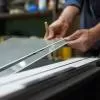VG SAKTHIKUMAR explains how new-age technologies can facilitate the growth of the
construction equipment industry.In recent research by McKinsey,
the construction industry was
compared to key industries,
most of whom are already on
track when it comes to AI adoption.
While all of them are projected to
increase spending on new-age
technologies at a faster pace over the
next three years, adoption of AI
solutions remains quite low in the
construction industry. While others
have taken the first steps in
benefitting from digitisation and
using it as a competitive advantage,
that is not the case with the
construction sector. Thus, providing
advanced technologies through
construction equipment has the
potential to transform the concrete
equipment manufacturing industry.
The landscape for the Indian
construction equipment market has
been rather promising, with a major
upswing since 2015 and sales
growing by 24 per cent and crossing
the 90,000 unit sales milestone for
FY2017-18. However, this figure
dropped down to 70,000 units for
2018-2019. Despite this upheaval,
there is every reason to hope that the
figure will soon get back to the
initial growth trajectory. This has
been greatly propelled by the
current Government’s focus on
infrastructure development. India is
thus at the threshold of becoming
one of the fastest infrastructure
developing countries in the world
with almost 27 km of highways
being developed on a daily basis
across the country.
Given this great growth
opportunity in the construction
industry, deploying smart
construction equipment would
increase demand, apart from
assuring resources for the future. Current challenges in the
construction industry
Lack of intelligence: While the
retail supply chain and pharma
companies have greatly utilised
AI to reduce manufacturing
downtime and oversupply and
increase predictability of
shipments, the construction
industry is yet to follow suit,
despite the promise that
deploying natural language
processing and robotics holds.Limited resources and financial
limitation in R&D are another
challenge. AI cannot flourish
without sustainable digitisation. Therefore, one should
understand what other industries
are using AI for and consider if
those applications can be
translated to the construction
industry too.
Inventory challenges: Managing
inventory is an existing challenge
in the construction industry. This
is because most customers do not
plan their requirement in
advance owing to many reasons,
such as the Government’s project
sanctions, delay in project
completion, money inflow, etc.
The lead time required for
manufacturing equipment is
more and, hence, you need a
committed number of workforce.
In addition, a sudden decrease in
the market requirement would
increase inventory at the
manufacturer’s and supplier’s
factories. For this reason,
companies need to continuously
manufacture equipment
anticipating customer
orders with knowledge of
upcoming projects.
Unplanned incidents and
accidents: Unplanned incidents
and onsite accidents are still a
challenge in the present scenario
but techno industries are
working towards providing a safe
work environment zone. For
instance, innovations like digital
fencing systems to alert upon the
entry of unauthorised personnelat hazardous or dangerous work
zones through a face recognition
system are now being taken up
for research.
Digitising construction
equipment to counter these
challengesSafety: AI engines are beginning
to emerge in the industry.
Nowadays, a lot of unmanned
equipment is being put into
operation considering safety.
Even a lot of heavy-duty
equipment, like truck-mounted
concrete boom pumps, is
provided with radio remote to
operate from a safe distance.Customer service: Digitisation
has brought about a wide change
in the customer service or
support area. This has helped in
tracking equipment with service
logs, which helps provide
proactive and easy service
maintenance. For instance, we
can track details like output of
the plant, the number of hours
put in operation per day, etc,
from our factory though remote
monitoring software.100 per cent uptime: There aresolutions to track the lifecycle of
critical components and systems
that trigger when service is due.
The system automatically
reminds you of the maintenance
schedule when key components
are overused. This, in turn, plays
a vital role in reducing the
machine’s downtime.Reduces inventory cost:
Product developments are a
continuous process with the
modular manufacturing concept.
We are following the theory of
constraints (TOC) concept to
manage our inventory to avoid
dumping of components. It also
gives a clearer picture for
purchasing supplies to use
resources effectively and helps us
manage zero/excess stock. The
concept also facilitates yard,
space and spares management.Vehicle maintenance: The
equipment process is monitored
round the clock. The
components received from
vendors and usage in production
are integrated with the ERP
along with the orders flow with a
forecast of the required material
for production, helping plan the
just in time (JIT) inventory. The
equipment is not only tracked to evaluate the process but trace
performance and efficiency,
which shows consumption of oil
and fuel with advanced sensors.
The data is send to the Cloud at
regular intervals.The answer is digitisation
The data is send to the Cloud at
regular intervalsThe answer is digitisation
Considering the challenges of
the construction industry, increasing
digitisation allows us to deploy
construction machines more
efficiently, thus saving money and
energy. Digitising will also provide
equipment manufacturers more
value in their attempts to make the
construction site smarter. Given that
India is at the threshold of major
growth, it is imperative that the
country analyse and be conscious
of the niche demands in the space.
The need of the hour is to be
more cognisant of our choice of
construction equipment–digitisation
could be the answer to that.
Currently, Schwing Stetter India
(SSI) is one of the first and only
players to deploy advanced solutions
like virtual reality (VR)-based
technology as part of its operator
training course. In the past, trainees
had to undergo rigorous manual
training over two months to learn
how to operate the machine and maintain it. This duration has now
been reduced to just two weeks,
thereby saving on time and cost.
SSI’s VR-based technology makes
them conversant and comfortable in
controlled conditions. Also, by
employing this innovation, the
customers and original equipment
manufacturer (OEM) eliminate
spending on any safety challenges by
the operator.The current age of automation
will be driven by unprecedented
technological advances. As
technology is gradually transforming
various industries, the Indian
manufacturing industry is also
taking great strides in this regard.
The Government’s ‘Make in India’
and ‘Vocal for Local’ initiatives will
do much to place India on the world
map as a manufacturing hub and
give global recognition to the Indian
economy. Technologies like AI and
VR will greatly benefit the job
market and enable reskilling of
employees. Other innovations like
3D printing, robotics, drones,
self-driving trucks and Internet of
Things (IoT) technology are
boosting the industry like never
before. Industry and the
Government must therefore address
these challenges, ranging from
inadequate infrastructure and
domestic supply chain and logistics,
to the high cost of doing business
and R&D efforts.
.ABOUT THE AUTHOR:
VG Sakthikumar, Managing Director,
Schwing Stetter India Pvt Ltd, has been
associated with the company since its
inception in India in 1998. He has over two
decades of experience in the ready-mix
concrete business. He took charge as
chief operating officer in 2006 and has
since contributed significantly to building
the brand. Having consolidated Schwing
Stetter’s position in India, he now also
handles the SAARC and ASEAN nations
from India. Further, he is Convener of the
Membership Panel of the Indian
Construction Equipment Manufactures’
Association (ICEMA) and Chairman of
the Mechanisation Committee of the
Builders’ Association of India (BAI).


















